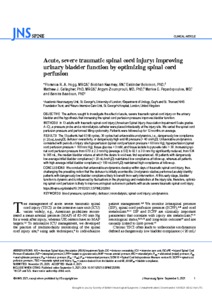Hogg, FRA; Kearney, S; Solomon, E; Gallagher, MJ; Zoumprouli, A; Papadopoulos, MC; Saadoun, S
(2022)
Acute, severe traumatic spinal cord injury: improving urinary bladder function by optimizing spinal cord perfusion.
J Neurosurg Spine, 36 (1).
pp. 145-152.
ISSN 1547-5646
https://doi.org/10.3171/2021.3.SPINE202056
SGUL Authors: Papadopoulos, Marios
![[img]](https://openaccess.sgul.ac.uk/113656/3.hassmallThumbnailVersion/JNeurosurgSpine2021.pdf)  Preview |
|
PDF
Published Version
Available under License ["licenses_description_publisher" not defined].
Download (988kB)
| Preview
|
Abstract
OBJECTIVE: The authors sought to investigate the effect of acute, severe traumatic spinal cord injury on the urinary bladder and the hypothesis that increasing the spinal cord perfusion pressure improves bladder function. METHODS: In 13 adults with traumatic spinal cord injury (American Spinal Injury Association Impairment Scale grades A-C), a pressure probe and a microdialysis catheter were placed intradurally at the injury site. We varied the spinal cord perfusion pressure and performed filling cystometry. Patients were followed up for 12 months on average. RESULTS: The 13 patients had 63 fill cycles; 38 cycles had unfavorable urodynamics, i.e., dangerously low compliance (< 20 mL/cmH2O), detrusor overactivity, or dangerously high end-fill pressure (> 40 cmH2O). Unfavorable urodynamics correlated with periods of injury site hypoperfusion (spinal cord perfusion pressure < 60 mm Hg), hyperperfusion (spinal cord perfusion pressure > 100 mm Hg), tissue glucose < 3 mM, and tissue lactate to pyruvate ratio > 30. Increasing spinal cord perfusion pressure from 67.0 ± 2.3 mm Hg (average ± SE) to 92.1 ± 3.0 mm Hg significantly reduced, from 534 to 365 mL, the median bladder volume at which the desire to void was first experienced. All patients with dangerously low average initial bladder compliance (< 20 mL/cmH2O) maintained low compliance at follow-up, whereas all patients with high average initial bladder compliance (> 100 mL/cmH2O) maintained high compliance at follow-up. CONCLUSIONS: We conclude that unfavorable urodynamics develop within days of traumatic spinal cord injury, thus challenging the prevailing notion that the detrusor is initially acontractile. Urodynamic studies performed acutely identify patients with dangerously low bladder compliance likely to benefit from early intervention. At this early stage, bladder function is dynamic and is influenced by fluctuations in the physiology and metabolism at the injury site; therefore, optimizing spinal cord perfusion is likely to improve urological outcome in patients with acute severe traumatic spinal cord injury.
Statistics
Item downloaded times since 05 Oct 2021.
Actions (login required)
 |
Edit Item |



